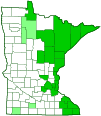white baneberry
(Actaea pachypoda)
Conservation • Wetland • Description • Habitat • Ecology • Use • Distribution • Taxonomy
Conservation Status |
|
|||||||
| IUCN Red List | not listed |
|||||||
| NatureServe | N5 - Secure SNR - Unranked |
|||||||
| Minnesota | not listed |
|||||||
Wetland Indicator Status |
||||||||
| Midwest | FACU - Facultative upland |
|||||||
| Northcentral & Northeast | UPL - Obligate upland |
|||||||
Description |
||
White baneberry is a 18″ to 36″ tall, erect, perennial forb that rises from a large, thick rhizome. The stems are erect and hairless. The leaves are alternate. The lower leaves are on long stalks, the upper leaves on shorter stalks. They are divided into 3 segments, with each segment divided into 3 leaflets. The leaflets are egg-shaped to oblong and may be unlobed or have 1 to 3 lobes. The margins have deep, sharp, irregular teeth. The upper leaflet surface is hairless. The lower surface is usually hairless. The inflorescence is a dense, slightly elongated cluster on a long stalk with 25 or more flowers rising at the end of the stem or from an upper leaf axil. It is ¾″ to 6¾″ long and usually longer than wide. The flowers are ¼″ wide. There are 4 to 10 white petals which soon fall off leaving 15 to 50 stamens. The fruit is a white, nearly globular berry with a black dot at the tip. The berry contains several seeds. When fruiting the pedicels are bright red and stout, as thick as the stalk to which they are attached. |
||
Height |
||
18″ to 36″ |
||
Flower Color |
||
White |
||
Similar Species |
||
Red baneberry (Actaea rubra ssp. rubra) leaflet lower surface is commonly hairy, at least with hairs along the veins. The flower clusters are ball-shaped, as wide as long. The berries are red. When fruiting the pedicels are dull green or brown and slender, thinner than the stalk to which they are attached. The form Actaea pachypoda f. rubrocarpa has red or pink berries. It is uncommon. It may be a hybrid of Actaea pachypoda and Actaea rubra, as its fruits are sterile. |
||
Habitat |
||
Moderate moisture. Woods. |
||
Ecology |
||
Flowering |
||
May to June |
||
Pests and Diseases |
||
|
||
Use |
||
|
||
Distribution |
||||
|
Sources BONAP includes records in Nobles and Watonwan Counties. iNaturalist includes unverified sightings in Belatrami and Clearwater Counties. All of these (light green) are well outside the species known range, and for that reason are suspect. |
|||
| 7/30/2022 | ||||
Nativity |
||||
Native |
||||
Occurrence |
||||
|
||||
Taxonomy |
|||
| Kingdom | Plantae (Plants) | ||
| Subkingdom | Pteridobiotina | ||
| Phylum | Tracheophyta (Vascular Plants) | ||
| Class | Magnoliopsida (Dicots) | ||
Order |
Ranunculales (Buttercups, Poppies, and Allies) | ||
Family |
Ranunculaceae (Buttercup) | ||
| Subfamily | Ranunculoideae (Anemones, Buttercups, Larkspurs, and Allies) | ||
| Tribe | Actaeeae (Baneberries, Cohoshes, and Winter Aconites) | ||
Genus |
Actaea (Baneberries and Cohoshes) | ||
| Section | Actaea | ||
Subordinate Taxa |
|||
Synonyms |
|||
| Actaea alba | |||
Common Names |
|||
baneberry doll’s eyes doll’s-eyes white baneberry |
|||
Glossary
Axil
The upper angle where the leaf stalk meets the stem.
Pedicel
On plants: the stalk of a single flower in a cluster of flowers. On insects: the second segment of the antennae. On Hymenoptera and Araneae: the narrow stalk connecting the thorax to the abdomen: the preferred term is petiole.
Rhizome
A horizontal, usually underground stem. It serves as a reproductive structure, producing roots below and shoots above at the nodes.
Visitor Photos |
|||||
Share your photo of this plant. |
|||||
| This button not working for you? Simply email us at info@MinnesotaSeasons.com. Attach one or more photos and, if you like, a caption. |
|||||
MinnesotaSeasons.com Photos |
|||||
|
|||||


Visitor Videos |
|||
Share your video of this plant. |
|||
| This button not working for you? Simply email us at info@MinnesotaSeasons.com. Attach a video, a YouTube link, or a cloud storage link. |
|||
Other Videos |
|||
| 01 Actaea pachypoda Séquence 2-Vivaces printanières 1.m4v Jean Désorcy |
|||
About
Uploaded on Jan 9, 2010 L'Actée à gros pieds du printemps à l'automne. Big feet Banberrt from spring to fall. Actaea con pies larga de la primavera hasta el otoño |
|||
| Doll's-eyes (Actaea pachypoda) colong7034 |
|||
About
Published on Sep 1, 2014 Doll's-eyes (Actaea pachypoda) aka white baneberry. Shot April/May and August 2014 in Transylvania County, NC |
|||

Visitor Sightings |
|||||
Report a sighting of this plant. |
|||||
| This button not working for you? Simply email us at info@MinnesotaSeasons.com. Be sure to include a location. |
|||||
|
|||||
MinnesotaSeasons.com Sightings |
|||||

|
Created: Last Updated: © MinnesotaSeasons.com. All rights reserved. |



